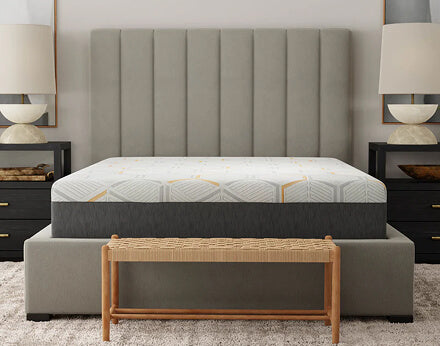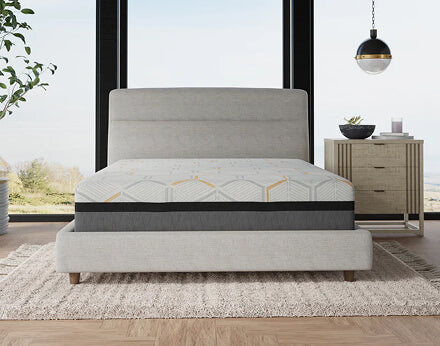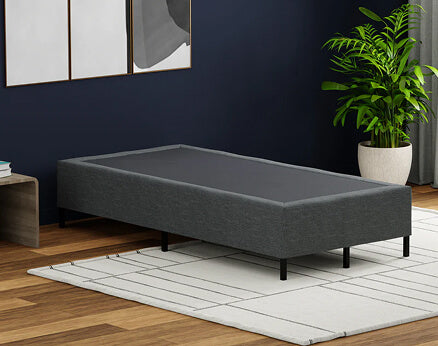Are allergies keeping you from getting a good night's sleep? You're not alone.
Your bedroom should be a sanctuary, but it can quickly become a hotspot for allergens like dust mites, pet dander, mold, and pollen.
This guide will help you tackle these allergens with practical steps focused on non-toxic mattresses, bedding, humidity control, cleaning, and improving air quality.
Discover practical strategies to create a healthier, allergen-free sleeping environment and enjoy restful nights.
Bedding and Mattress Management
Your bed is where you spend a significant part of your life. It's also a prime location for allergens to accumulate. Proper care and selection of bedding and mattresses are crucial for minimizing allergens in your sleeping environment.
Use Allergen-Proof Covers
Invest in allergen-proof covers for your mattress, pillows, and box springs. These covers are created of tightly woven fabric that stops dust mites from colonizing or escaping.
Additionally, choosing a non-toxic mattress or a safe mattress can help reduce exposure to harmful chemicals, providing a safer sleep environment.
Wash Bedding Regularly
Make it a habit to wash all your bedding-sheets, pillowcases, and blankets-weekly in hot water (at least 130°F). This temperature effectively kills dust mites and removes other allergens. If your bedding can't be washed in hot water, use a hot dryer for at least 15 minutes.
Choose Hypoallergenic Bedding
Opt for bedding materials that are less likely to harbor allergens. Bamboo pillows are an excellent option because they are naturally hypoallergenic and mold and dust mites resistant.
Humidity Control
Managing humidity levels in your bedroom is essential for creating an environment less conducive to allergens like dust mites and mold. Keeping moisture under control can make a significant difference in allergy management.
Maintain Low Humidity
Keep indoor humidity below 50% to discourage the growth of dust mites and mold. Use dehumidifiers or air conditioners to maintain these levels. A hygrometer at most hardware stores can help you monitor humidity levels.
Use a Hygrometer
Regularly check the humidity in your bedroom to ensure it stays within the recommended range. This simple device can help you maintain an environment that is less hospitable to allergens.
Cleaning and Maintenance
Thorough and consistent cleaning of your bedroom can significantly reduce allergens. Developing a consistent cleaning routine is vital in maintaining a healthy sleep environment.
Regular Dusting
Use damp or microfiber cloths to dust surfaces. Dry dusting can spread allergens into the air. Clean all surfaces, including furniture and electronics, to reduce dust accumulation.
Vacuuming

Vacuuming carpets, rugs, and upholstered furniture with a HEPA-filter-equipped vacuum cleaner is crucial. HEPA filters capture fine particles, preventing them from becoming airborne and reducing allergen levels in your bedroom.
Reduce Clutter
Minimize the number of items that can collect dust, such as knickknacks, books, and magazines. Keeping surfaces clear makes it easier to clean and reduces places for dust to settle.
Flooring and Furnishings
The flooring and furnishing types in your bedroom significantly affect allergen control. Opting for easy-to-clean materials can help reduce the buildup of allergens.
Replace Carpeting
Carpets can carry dust mites and other allergens. Replace wall-to-wall carpets with complex wood, vinyl, or tile flooring options. These materials are easier to clean and do not trap allergens.
Washable Rugs
Use small, washable rugs instead of large, unwashable ones. Wash these rugs regularly to keep dust mites and allergens at bay.
Opt for Minimal Furnishings
Select furnishings that are easy to clean and less likely to collect dust. Avoid upholstered furniture, heavy drapes, and horizontal blinds.
Pet Management
While pets are beloved family members, they can introduce allergens into your bedroom. Effective pet management can help keep your sleeping area allergen-free.
Keep Pets Out of the Bedroom
Establish your bedroom as a pet-free zone to minimize exposure to pet dander. This can significantly reduce allergen levels where you sleep.
Frequent Pet Baths
Regularly bathing your pets can reduce the amount of dander they shed. Ideally, someone without allergies should handle the bathing to avoid exposure.
Mold Prevention
Mold spores thrive in damp environments and are common allergens in bedrooms. Preventing their growth is vital for maintaining a healthy indoor environment.
Control Moisture
Fix any leaks and use exhaust fans in bathrooms to reduce humidity. Ensuring your bedroom remains dry can prevent mold growth.
Clean Regularly
Clean areas prone to mold regularly with mold-killing solutions. Ensure good ventilation in your bedroom to keep the air dry and fresh.
Air Quality Improvement
Good air quality is fundamental to reducing allergens in your bedroom. Utilizing air purifiers and maintaining clean air systems can significantly enhance your indoor environment.
Air Purifiers

Use HEPA air purifiers to reduce airborne allergens. Place these purifiers in strategic locations to maximize their effectiveness.
Filter Replacement
Ensure you change the filters in your heating and air conditioning units regularly. Opt for filters with a high Minimum Efficiency Reporting Value (MERV) rating to capture the most allergens effectively.
Allergy-Friendly Practices
Adopting allergy-friendly habits in your daily routine can minimize allergens and promote a healthier home environment.
Avoid Indoor Plants
Some indoor plants can harbor mold and other allergens. If you enjoy having plants, choose hypoallergenic varieties that do not release pollen or attract mold.
No Smoking
Prohibit smoking inside your home. Tobacco smoke can worsen allergy symptoms and reduce indoor air quality.
Achieve Your Best Sleep
Implementing the methods detailed in this guide can greatly reduce allergens in your bedroom, creating a healthier and more restful sleep environment.
Remember, the key to managing allergies is consistency and attention to detail. Invest in allergen-proof covers, maintain low humidity levels, clean regularly, and choose hypoallergenic materials like bamboo pillows and non-toxic mattresses.
By making these changes, you can create a bedroom that genuinely supports your well-being and ensures you wake up refreshed and allergy-free.
Ready to enhance your sleep quality and minimize allergens in your bedroom? Blissful Nights offers a selection of non-toxic mattresses, bamboo pillows, and other hypoallergenic bedding solutions.
Contact us today for expert advice and learn how our products can help you achieve a healthier, allergen-free sleeping environment.
FAQs
Can air purifiers help with bedroom allergies?
Yes! HEPA filter-equipped purifiers can capture airborne allergens.
Are hypoallergenic pillows and mattresses worth the investment?
Yes, they can significantly reduce exposure to allergens and improve sleep quality.
What should I do if my allergies worsen despite following these tips?
If your allergies worsen, consider consulting an allergist. They can provide specific treatments and identify any additional triggers you may need to address.






















Leave a comment
This site is protected by hCaptcha and the hCaptcha Privacy Policy and Terms of Service apply.